Weevil
Weevils are beetles belonging to the superfamily Curculionoidea, known for their elongated snouts. They are usually small, less than 6 mm (1⁄4 in) in length, and herbivorous. About 97,000 species of weevils are known. They belong to several families, with most of them in the family Curculionidae (the true weevils). Some other beetles, although not closely related, bear the name "weevil", such as the biscuit weevil (Stegobium paniceum), which belongs to the family Ptinidae.
| Weevils | |
|---|---|
 | |
| Scientific classification | |
| Kingdom: | Animalia |
| Phylum: | Arthropoda |
| Class: | Insecta |
| Order: | Coleoptera |
| Suborder: | Polyphaga |
| Infraorder: | Cucujiformia |
| Clade: | Phytophaga |
| Superfamily: | Curculionoidea Latreille, 1802 |
| Families | |
Many weevils are considered pests because of their ability to damage and kill crops. The grain or wheat weevil (Sitophilus granarius) damages stored grain, as does the maize weevil (Sitophilus zeamais) among others. The boll weevil (Anthonomus grandis) attacks cotton crops; it lays its eggs inside cotton bolls and the larvae eat their way out. Other weevils are used for biological control of invasive plants.
A weevil's rostrum, or elongated snout, hosts chewing mouthparts instead of the piercing mouthparts that proboscis-possessing insects are known for. The mouthparts are often used to excavate tunnels into grains.[1] In more derived weevils, the rostrum has a groove in which the weevil can fold the first segment of its antennae.
Some weevils have the ability to fly, such as the rice weevil.[2][3]
One species of weevil, Austroplatypus incompertus, exhibits eusociality, one of the few insects outside the Hymenoptera and the Isoptera to do so.
Taxonomy and phylogeny
Because so many species exist in such diversity, the higher classification of weevils is in a state of flux. They are generally divided into two major divisions, the Orthoceri or primitive weevils, and the Gonatoceri or true weevils (Curculionidae). E. C. Zimmerman proposed a third division, the Heteromorphi, for several intermediate forms.[4] Primitive weevils are distinguished by having straight antennae, while true weevils have elbowed (geniculate) antennae. The elbow occurs at the end of the scape (first antennal segment) in true weevils, and the scape is usually much longer than the other antennal segments. Some exceptions occur. Nanophyini are primitive weevils (with very long trochanters), but have long scapes and geniculate antennae. From the true weevils, Gonipterinae and Ramphus have short scapes and little or no elbow.
A 1995 classification system to family level was provided by Kuschel,[5] with updates from Marvaldi et al. in 2002,[6] and was achieved using phylogenetic analyses. The accepted families were the primitive weevils, Anthribidae, Attelabidae, Belidae, Brentidae, Caridae, and Nemonychidae, and the true weevils Curculionidae. Most other weevil families were demoted to subfamilies or tribes. Further work resulted in the elevation of Cimberididae to family from placement as a Nemonychidae subfamily in 2017 and the recognition of the Cretaceous age family Mesophyletidae in 2018 from Burmese amber.[7] Weevil species radiation was shown to follow steps in plant evolution upon which the weevils feed; they can vary in color from black to light brown.
A phylogeny of the Curculionoidae based on 18S ribosomal DNA comparison and morphological data conducted by Marvaldi et al in 2002 is suggested below:[6]
| |||||||||||||||||||||||||||||||||||||
Families
- Anthribidae—fungus weevils
- Attelabidae—leaf rolling weevils
- Belidae—primitive weevils
- Brentidae—straight snout weevils
- Caridae
- Cimberididae
- Curculionidae—true weevils
- †Mesophyletidae
- Nemonychidae—pine flower weevils
Sexual dimorphism
Rhopalapion longirostre exhibits an extreme case of sexual dimorphism. The female rostrum is twice as long and its surface is smoother than in the male. The female bores egg channels into the buds of Alcea rosea. Thus, the dimorphism is not attributed to sexual selection. It is a response to ecological demands of egg deposition.[8]
Another example of extreme dimorphism in weevils is that of the New Zealand giraffe weevil, males measure up to 90 mm, and females 50 mm, although there is an extreme range of body sizes in both sexes.
Gallery
 Aades cultratus
Aades cultratus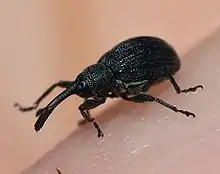

_longirostre.jpg.webp) Apion (Rhopalapion) longirostre
Apion (Rhopalapion) longirostre
 Bantiades rectalis
Bantiades rectalis







 Furcipus rectirostris
Furcipus rectirostris


_pinastri_01.JPG.webp) Hylobius (Callirus) pinastri
Hylobius (Callirus) pinastri_larva.jpg.webp) Hypera rumicis larva
Hypera rumicis larva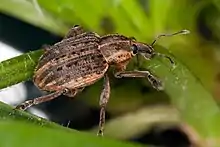

 Liparus glabiostris
Liparus glabiostris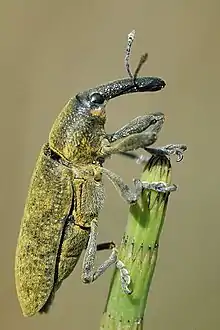
.jpg.webp)
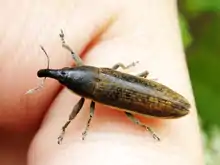


 Orychodes indus
Orychodes indus Phyllerythrurus sanguinolentus
Phyllerythrurus sanguinolentus



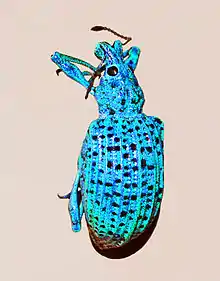
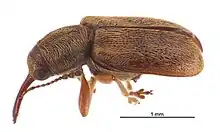



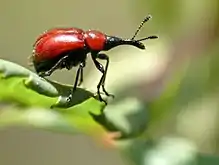 Rhynchites bicolor
Rhynchites bicolor

 Sitona gressorius
Sitona gressorius

 Vanapa oberthuri
Vanapa oberthuri
References
- Moon, Myung-Jin (2015). "Microstructure of mandibulate mouthparts in the greater rice weevil, Sitophilus zeamais (Coleoptera: Curculionidae)". Entomological Research. 45 (1): 9–15. doi:10.1111/1748-5967.12086. ISSN 1748-5967.
- "What Is a Weevil and How Did That Bug Get in My Food?".
- "Weevils on Stored Grain (Department of Entomology)". Department of Entomology (Penn State University).
- E. C. Zimmerman (1994). Australian weevils (Coleoptera: Curculionidae). Volume 1. Orthoceri: Anthribidae to Attelabidae: the primitive weevils. East Melbourne: CSIRO. pp. 741 pp.
- G. Kuschel (1995). "A phylogenetic classification of Curculionoidea to families and subfamilies". Memoirs of the Entomological Society of Washington. 14: 5–33.
- A. E. Marvaldi, A. S. Sequeira, C. W. O'Brien & B. D. Farrell (2002). "Molecular and morphological phylogenetics of weevils (Coleoptera, Curculionidae): do niche shifts accompany diversification?". Systematic Biology. 51 (5): 761–785. doi:10.1080/10635150290102465. PMID 12396590.CS1 maint: multiple names: authors list (link)
- Dave J. Clarke; Ajay Limaye; Duane D. McKenna; Rolf G. Oberprieler (2018). "The weevil fauna preserved in Burmese amber—snapshot of a unique, extinct lineage (Coleoptera: Curculionoidea)". Diversity. 11 (1): Article 1. doi:10.3390/d11010001.
- G. Wilhelm; et al. (2011). "Sexual dimorphism in head structures of the weevil Rhopalapion longirostre: a response to ecological demands of egg deposition". Biological Journal of the Linnean Society. 104: 642–660. doi:10.1111/j.1095-8312.2011.01751.x.
Further reading
- Bright, Donald E.; Bouchard, Patrice (2008). Coleoptera, Curculionidae, Entiminae: Weevils of Canada and Alaska Volume 2. Insects and Arachnids of Canada Series, Part 25. Ottawa: NRC Research Press. ISBN 978-0-660-19400-4.
External links
 Media related to Curculionoidea at Wikimedia Commons
Media related to Curculionoidea at Wikimedia Commons